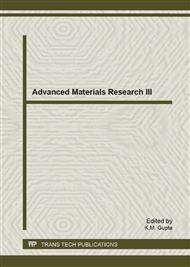[1]
Ancona M, Yu Z, Lee W, Dutton R, Voorde P (1999),in: Simulation of quantum confinement effects in ultra-thin-oxide MOS structures IEEE J TCAD 11:1-17.
DOI: 10.1109/tcad.1996.6449168
Google Scholar
[2]
S. Birner, in : Nextnano3, next generation 3D nanodevice simulator web site, Information on http://www.nextnano.de/nextnano3l/tutorial.htm.
Google Scholar
[3]
B. Majkusiak, T. Janik, J. Walczak, in : Semiconductor thickness effects in the double-gate SOI MOSFET, IEEE Trans Electron Dev, 45(5):1127–34, (1998).
DOI: 10.1109/16.669563
Google Scholar
[4]
Stefan Birner, Tobias Zibold, Till Andlauer, Tillmann Kubis, Matthias Sabathil, Alex Trellakis, and Peter Vogl, in : Nextnano: General Purpose 3-D Simulations, IEEE Transactions on Electron Devices, vol. 54, no. 9, September(2007).
DOI: 10.1109/ted.2007.902871
Google Scholar
[5]
Jg. Fossum, in: physical insights on double-gate MOSFETs, in proc.COMAC(Government Microcircuit Application Conf.),Mar.(2001).,pp.322-325.
Google Scholar
[6]
ITRS Roadmap, Semiconductor Industry Association. CA: San Jose; (2006).
Google Scholar
[7]
Nextnano: General Purpose 3-D Simulations Stefan Birner, Tobias Zibold, Till Andlauer, Tillmann Kubis, Matthias Sabathil, Alex Trellakis, and Peter Vogl. IEEE TRANSACTIONS ON ELECTRON DEVICES, VOL. 54, NO. 9, SEPTEMBER (2007).
DOI: 10.1109/ted.2007.902871
Google Scholar
[8]
Alex Trellakis ,Tobias Zibold, Till AndlauerE, in :The 3Dnanometer device project nextnano:concepts ,methods,results, spriger science+business Medias ,LLC (2006).
Google Scholar
[9]
F. Liu, L. Zhang, J. Zhang, J. He, and M. Chang," Effects of body doping on threshold voltage and channel of symmetric DG MOSFETs with continuous solution from accumulation to strong-inversion regions, in :Semicond.Sci.Technol.,Vol.24, No.8,p.085005(8pp),(2009).
DOI: 10.1088/0268-1242/24/8/085005
Google Scholar
[10]
H. Lu, W.Y. Lu, and Y. Taur," Effects of body doping on double-gate MOSFET characteristics, in: Semicond.Sci.Technol, Vol.23, No.1,(2008).
DOI: 10.1088/0268-1242/23/1/015006
Google Scholar
[11]
S. Slimani, B. Djellouli, The Impact of High Dielectric Permittivity on SOI Double-Gate Mosfet Using Nextnano Simulator, in: Sensors & Transducers Journal, Vol.14-1, Special Issue, March 2012, pp.231-243.
Google Scholar


